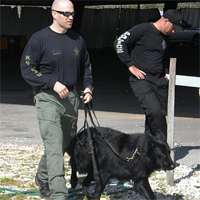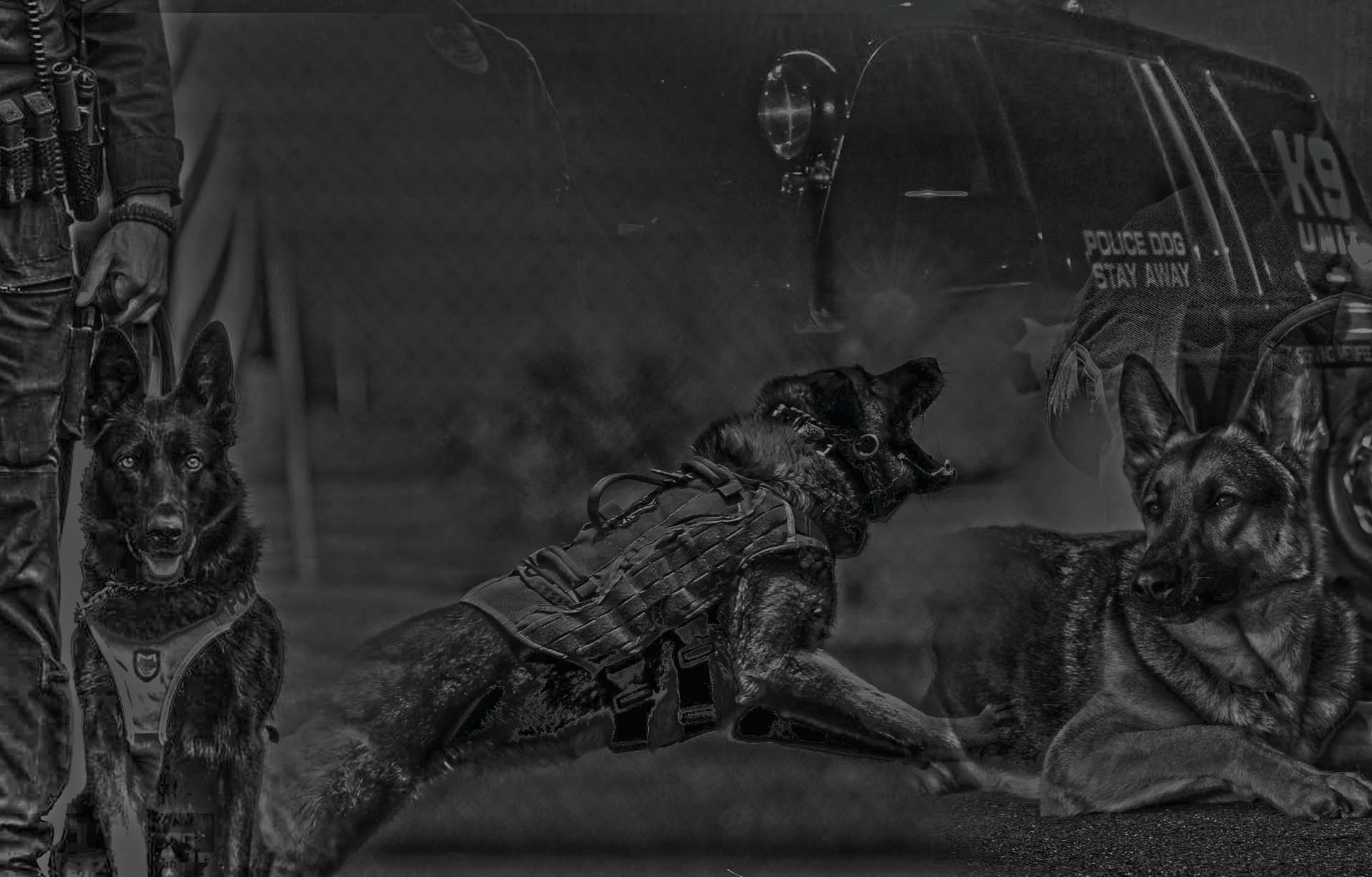The Florida Law Enforcement Canine Association Patrol Certification will consist of five phases.
The K-9 team must pass all phases except either the area search or the building search to receive the Patrol Certificate.
The five phases are:
- Obedience
- Criminal apprehension
- Call off
- Building search
- Area search
 The K-9 team must pass the obedience phase first to continue the certification. The certification may be terminated at any time if the Certifying Officials determine the dog is not under control.
The K-9 team must pass the obedience phase first to continue the certification. The certification may be terminated at any time if the Certifying Officials determine the dog is not under control.
Dog will wear only on duty equipment.
If electric collars are worn, the handler will give the transmitter to the officials and the receiver will be turned off.
There will be two Certifying Officials present for the certification.
If the K-9 team fails any portion of the test, they may re-test the portion failed within 5 days. The team must wait 48 hrs. before re-testing.
If you do not certify within 5 days, the team will be required to perform the entire test.
Agency requesting certification shall provide decoy and equipment, along with locations for certifications.
Obedience
Objectives:
- The K-9 team will heel at different directions and at all times remaining under control at the handlers side.
- The test consists of the following exercises with the dog off lead.
- The dog will heel on a course with a minimum of two left turns, two right turns and an about face. The team will walk three legs with a turn at the end of each leg. Each leg will be a minimum of 20 yards in length. At some point during the heeling phase, at the direction of the Certifying Official, a shot from a .38 caliber blank gun will be fired by a helper who is out of sight and at least 100 feet and no more than 150 feet from the starting line. At the halfway point on the final leg, the dog will be commanded to a sit, stand or down in motion. The handler will then continue to the end of the leg, turn and face the dog. At the direction of the Certifying Official the handler, using verbal and or hand commands, will command the dog to 2 different positions. Finally the handler will call the dog to a heel position.
- The test will be judged Pass/Fail.
- A passing score for the heeling phase will be the dog staying under control at the handlers side. The dog on the initial command must complete three out of the four commands, one while in motion, 2 different distance positions and the recall to the heel position. A minimal amount of forging or lagging will not be considered a failure.
Criminal Apprehension
This test is designed to show the dogs ability to apprehend a suspect by biting and holding until released by command from the handler. The K-9 team will be judged on the pursuit, bite and release.
Release: When the handler verbally commands the dog to release, the dog shall:
- Respond to the command of the handler (limit of four commands in a reasonable amount of time).
- Release the bite.
- Remain alert and ready to respond to furtive movement.
Procedure:
The dog will be deployed off lead.
The decoy will wear suitable protective clothing.
The handler may hold the dog at the starting position designated by the certifying official.
The decoy will appear at a distance of approximately thirty yards. The handler will issue two announcements. After the first announcement, the decoy will begin jogging away from the team.
Following the second announcement, the handler will deploy the dog. The dog will pursue and engage the decoy by biting and attempt to subdue.
The decoy will stop jogging when engaged by the dog. The decoy will agitate the dog until ordered to stop resisting. The decoy will comply.
The handler will issue the command to release the bite. The dog will release the bite.
Upon release of the bite, it will be the handlers discretion to leave the dog in a guard position or call the dog to the heel position.
The test will be judged Pass/Fail.
Passing score will be:
The dog will stay on the bite until released by command from the handler.
The dog must release the bite with no more than four commands with the handler a minimum of 10 ft. from the dog.
The dog must not re-engage prior to the handler taking control.
Call Off
The K-9 team will begin the exercise in an area approximately 100 yards long and 40 yards wide, with a number of places to conceal a decoy. At this point of the exercise it can be done on or off lead.
At some point during the exercise, the decoy will come out from hiding at a distance of approximately 40 yards. The decoy will begin jogging away from the K-9 team. At this point the dog will be off lead and will begin to pursue the decoy on command from the handler. The handler will remain at the spot the pursuit began. When the decoy observes the pursuit of the dog, he will stop jogging and assume a surrendering posture. The team will respond in one of three ways when the handler observes the decoys surrender.
- Disengage: On command from the handler, the dog will stop the pursuit and remain at the point of termination. The handler will move to the dog and take control.
- Recall: On command from the handler, the dog will stop the pursuit and return to the handler.
- Detain: The dog will approach the decoy and detain by holding and barking at a stand, sit or down. No verbal command will be given. The handler will move to the dog and take control.
The test ends when the handler takes control of the dog and is dismissed by the certifying official.
Aggressive contact with the decoy will be considered a failure.
Non- aggressive incidental contact is acceptable.
The pursuit must be a minimum of 10 yards.
The dog will be deployed with only on duty equipment.
The decoy will wear suitable protective clothing.
The test will be judged Pass/Fail and the appropriate box checked for the behavior exhibited.
A passing score will be:
The dog shows obvious pursuit of the decoy.
The dog makes no aggressive contact with the decoy when called off or detaining
Building Search
This test attempts to simulate a working situation where a suspect is avoiding apprehension by hiding within a building. The decoy will be concealed in a safe hide with no equipment and the certifying officials will accompany the handler.
Building types:
Residential dwelling, warehouse, barn, open garage/shop area, office building, school, hotel/motel etc. Building will be approximately 1000 1500 square feet.
There will be a time limit of 10 min.
Decoy:
Will be hidden for a minimum of 10 minutes prior to the test.
Will be in a safe hide with no bite equipment
Will enter/exit the building by a route other than where the dog will deploy.
The test will be off-lead with the dog wearing only on-duty equipment. The deployment will simulate an actual scenario utilizing tactics. The handler will act in compliance to their departments policy regarding announcements.
The dogs indication of the decoys location must be obvious.
The test ends when the handler calls the location of the decoy and takes control of the dog.
The test will be judged Pass/Fail.
Miscellaneous:
Being unable to forecast testing sites, several building types are listed to accommodate available buildings. The certifying official will make the final determination of which building to use and where the decoy will be hidden. The certifying official will determine appropriate times between searches. An effort will be made to make all searches fair and reasonable, yet designed to challenge the teams ability.
Area Search
This test attempts to simulate a suspect fleeing into an open area with a number of places to be used for concealment.
Area types:
Open fields, warehouse complexes, fenced in storage lots, etc.
Area to be searched will be approximately 150 ft. x 150 ft.
There will be a time limit of 10 min.
There must be at least six places a decoy can be concealed from sight.
Decoy:
Will be hidden for a minimum of 10 minutes prior to the test.
Will be in a safe hide with no bite equipment.
The test will be conducted on or off lead with the dog wearing only on-duty equipment.
The deployment will simulate an actual scenario utilizing tactics. The handler will act in compliance to their departments policy regarding announcements.
The dogs indication of the decoys location must be obvious.
The test ends when the handler calls the location of the decoy and takes control of the dog.
The test will be judged Pass/Fail
Miscellaneous:
Being unable to forecast testing sites, several areas are listed to accommodate available sites. The certifying official will make the final determination of which site to use and where the decoy will be hidden. The certifying official will determine appropriate times between searches. An effort will be made to make all searches fair and reasonable, yet designed to challenge the teams ability.

